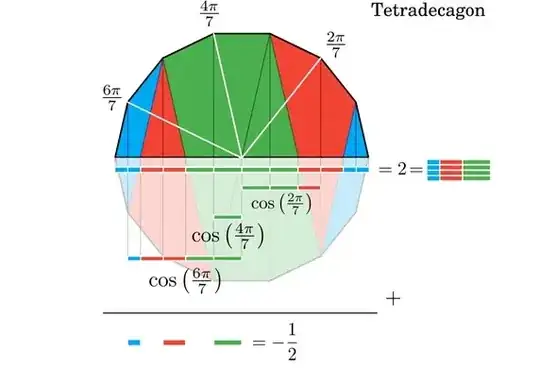$\require{color} \definecolor{blue}{RGB}{3,169,244} \definecolor{green}{RGB}{76,175,80} \definecolor{red}{RGB}{244,67,54} \newcommand{\k}[1]{\color{black}{\textsf{#1}}} \newcommand{\b}[1]{\color{blue}{\textsf{#1}}} \newcommand{\g}[1]{\color{green}{\textsf{#1}}} \newcommand{\r}[1]{\color{red}{\textsf{#1}}} \cos\left(\frac{2\pi}{7}\right)+\cos \left(\frac{4\pi}{7}\right)+\cos \left(\frac{6\pi}{7}\right) = -\frac{1}{2}$
Visual proof:

This regular 14-gon has a 'diameter' of 2. This diameter is the sum of four blue segments, four red segments and four green segments. But also each cosine can be expressed as a sum of these segments. Adding the three cosines yields the negative sum of one blue, one red and one green segment, which is $-\frac12$
Further explanation
Inside the regular Tetradecagon, the three cosines are the vertical projections of the nodes at $\{2\pi/ 7,4\pi/7,6\pi/7\}$ onto the horizontal diameter.
This diameter ($\textsf{D}=2$) is further divided into twelve smaller segments, by drawing some extra lines from the other nodes at the upper semicircle, located at $\{1\pi/7,3\pi/7,5\pi/7\}$.
The angle between all these (near) verticals is always the same, because all chord lengths are similar in a regular polygon. Therefore, the diameter $\textsf{D}$ consists of just three types of segments $\{\b b, \r r, \g g \}$:
$$\qquad \large \textsf{D} = \b{2b} \k + \r{2r} \k + \g{2g} \k{+} \g{2g} \k + \r{2r} \k + \b{2b} \k {= 2}$$
From which follows that:
$$\qquad \large \b{b} \k + \r{r} \k + \g{g} \k{=} \frac12$$
From the image, the sum of the three cosines can be easily expressed in these three types of segments:
$$\qquad \large \begin{align}\cos\left(\frac{2\pi}{7}\right) & = \g{2g} \k{+} \r r \\ \cos\left(\frac{4\pi}{7}\right) & = \k{-}\g g\\ \cos\left(\frac{6\pi}{7}\right) & = -\g{2g} \k{-} \r{2r} \k{-}\b b\\ \hline \\ \sum_{k=1}^3\cos\left(\frac{2k\pi}{7}\right) &= \k{-}\g g \k{-} \r{r} \k{-} \b{b} \k{=} -\frac12 \end{align}$$
$\blacksquare$

